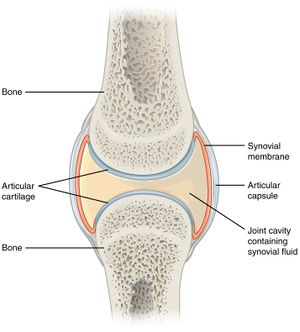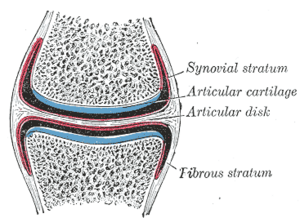Synovium & Synovial Fluid: Difference between revisions
No edit summary |
No edit summary |
||
| Line 32: | Line 32: | ||
Consists of: | Consists of: | ||
* | * Hyaluronic acid: a viscous glycosaminoglycan serves as a structural element and lubricant.<ref>MW dictionary hyaluronic acid Available: https://www.merriam-webster.com/dictionary/hyaluronic%20acid (accessed 18.6.2021)</ref> | ||
* Lubricin | * Lubricin: the most lubricating and anti-ahesive molecule in the human body. It is a surface-active mucinous glycoprotein secreted in the synovial joint and plays an important role in cartilage integrity. Lubricin molecules coat the cartilage surface, providing boundary lubrication and preventing cell and protein adhesion<ref>Jay GD, Waller KA. [https://www.sciencedirect.com/science/article/pii/S0945053X14001619 The biology of lubricin: near frictionless joint motion]. Matrix Biology. 2014 Oct 1;39:17-24.Available:https://www.sciencedirect.com/science/article/pii/S0945053X14001619 (accessed 18.6.2021)</ref> | ||
* Proteinase | * Proteinase: an enzyme that catalyzes proteolysis, the breakdown of proteins into smaller polypeptides or single amino acids. | ||
* Collagenases | * Collagenases: enzymes that break the peptide bonds in collagen. They assist in destroying extracellular structures in the pathogenesis of bacteria such as Clostridium. | ||
* Prostaglandins | * Prostaglandins: produced in nearly all cells and are part of the body's way of dealing with injury and illness.. They both sustain homeostatic functions and mediate pathogenic mechanisms, including the inflammatory response<ref>Ricciotti E, FitzGerald GA. Prostaglandins and inflammation. Arteriosclerosis, thrombosis, and vascular biology. 2011 May;31(5):986-1000.Available: https://www.ncbi.nlm.nih.gov/pmc/articles/PMC3081099/ (accessed 18.6.2021)</ref>. | ||
Biomechanics: | Biomechanics: | ||
* Synovial fluid exhibits non-Newtonian flow characteristics | * Synovial fluid exhibits non-Newtonian flow characteristics ie Viscosity coefficient is not a constant; Fluid is not linearly viscous; Viscosity increases as the shear rate decreases).<ref name=":0" /> | ||
== Resources == | == Resources == | ||
Revision as of 08:21, 18 June 2021
This article or area is currently under construction and may only be partially complete. Please come back soon to see the finished work! (18/06/2021)
Original Editor - Lucinda hampton
Top Contributors - Lucinda hampton, Kim Jackson and Kirenga Bamurange Liliane
Introduction[edit | edit source]
Synovium (also called the synovial membrane) is a specialized connective soft-tissue membrane that lines the inner surface of synovial joint capsules. Together with bone, articular cartilage, tendon, ligament, and fibrous capsule, it is an important component of the tissues that form an integrated joint. As such, it not only has its own specific functions but also interacts with other tissues in the joint both structurally and functionally[1].
Synovial fluid lubricates articular cartilage and provides nourishment through diffusion. It made from a ultrafiltrate of blood plasma, produced and regulated by the synovium.[2]
Anatomy[edit | edit source]
The synovial membrane consists of an
Intimal layer:
- Well innervated and vascularised containing different types of cells including fibroblasts, macrophages, adipocytes, nerve fibres, vascular endothelial cells as well as lymphocytes.
- Features two types of synoviocytes: type A - derived from macrophages; non-fixed cells with antigen presenting ability located in superficial layer; important in phagocytosis and fibroblastic. Type B cells - fibroblast like cells; rich rough endoplasmic reticulum and dendritic processes that reach out to the joint surface; located at various depths, frequently in deeper layer; produce synovial fluid[2].
Subintima layer
- Thicker layer of loose connective tissue which contains fewer cells
- Composed of fatty, fibrous or loose areolar tissue, allowing movement.[3].
Synovial Fluid[edit | edit source]
This fluid is generated from an ultrafiltrate of blood plasma which is regulated by synovium. The purpose of this fluid is to lubricate the cartilage of the bone joint and provide nourishment through diffusion. It is made from a ultrafiltrate of blood plasma and is regulated by the synovium. eg healthy knee contains ~2mL of synovial fluid.
Consists of:
- Hyaluronic acid: a viscous glycosaminoglycan serves as a structural element and lubricant.[4]
- Lubricin: the most lubricating and anti-ahesive molecule in the human body. It is a surface-active mucinous glycoprotein secreted in the synovial joint and plays an important role in cartilage integrity. Lubricin molecules coat the cartilage surface, providing boundary lubrication and preventing cell and protein adhesion[5]
- Proteinase: an enzyme that catalyzes proteolysis, the breakdown of proteins into smaller polypeptides or single amino acids.
- Collagenases: enzymes that break the peptide bonds in collagen. They assist in destroying extracellular structures in the pathogenesis of bacteria such as Clostridium.
- Prostaglandins: produced in nearly all cells and are part of the body's way of dealing with injury and illness.. They both sustain homeostatic functions and mediate pathogenic mechanisms, including the inflammatory response[6].
Biomechanics:
- Synovial fluid exhibits non-Newtonian flow characteristics ie Viscosity coefficient is not a constant; Fluid is not linearly viscous; Viscosity increases as the shear rate decreases).[2]
Resources[edit | edit source]
- bulleted list
- x
or
- numbered list
- x
References[edit | edit source]
- ↑ Musculoskeletal Key Synovium Available: https://musculoskeletalkey.com/synovium-and-joint-biology/(accessed 18.6.2021)
- ↑ 2.0 2.1 2.2 Orthobullets Synovium Available from:https://www.orthobullets.com/basic-science/9018/synovium-and-synovial-fluid (accessed 18.6.2021)
- ↑ Radiopedia Synovium Available from:https://radiopaedia.org/articles/synovium?lang=gb (accessed 18.6.2021)
- ↑ MW dictionary hyaluronic acid Available: https://www.merriam-webster.com/dictionary/hyaluronic%20acid (accessed 18.6.2021)
- ↑ Jay GD, Waller KA. The biology of lubricin: near frictionless joint motion. Matrix Biology. 2014 Oct 1;39:17-24.Available:https://www.sciencedirect.com/science/article/pii/S0945053X14001619 (accessed 18.6.2021)
- ↑ Ricciotti E, FitzGerald GA. Prostaglandins and inflammation. Arteriosclerosis, thrombosis, and vascular biology. 2011 May;31(5):986-1000.Available: https://www.ncbi.nlm.nih.gov/pmc/articles/PMC3081099/ (accessed 18.6.2021)








